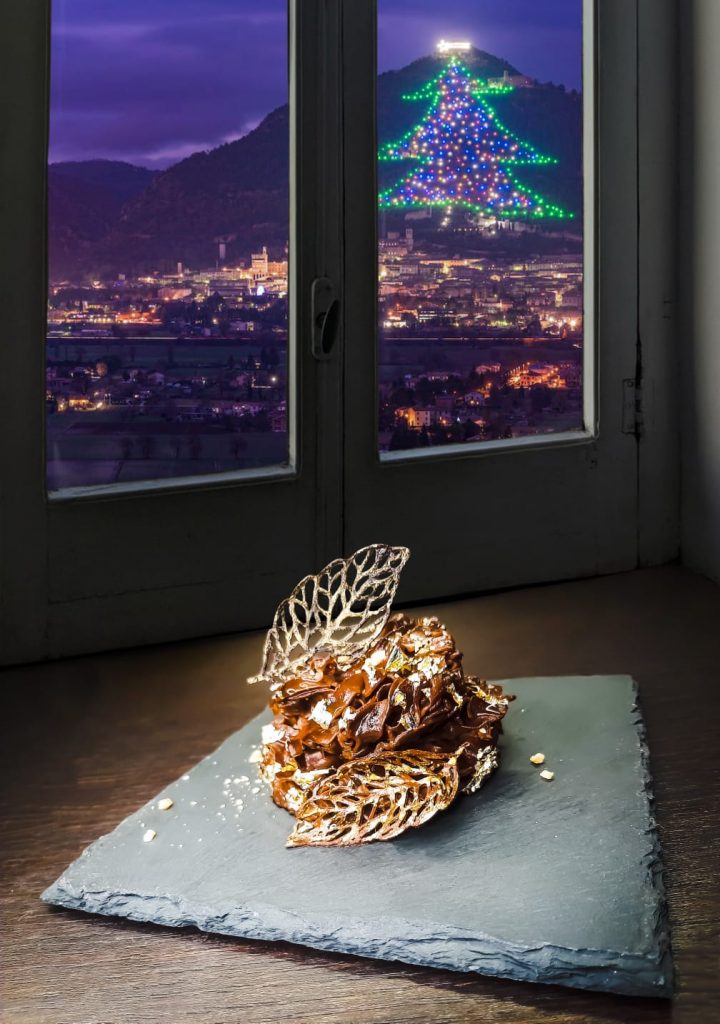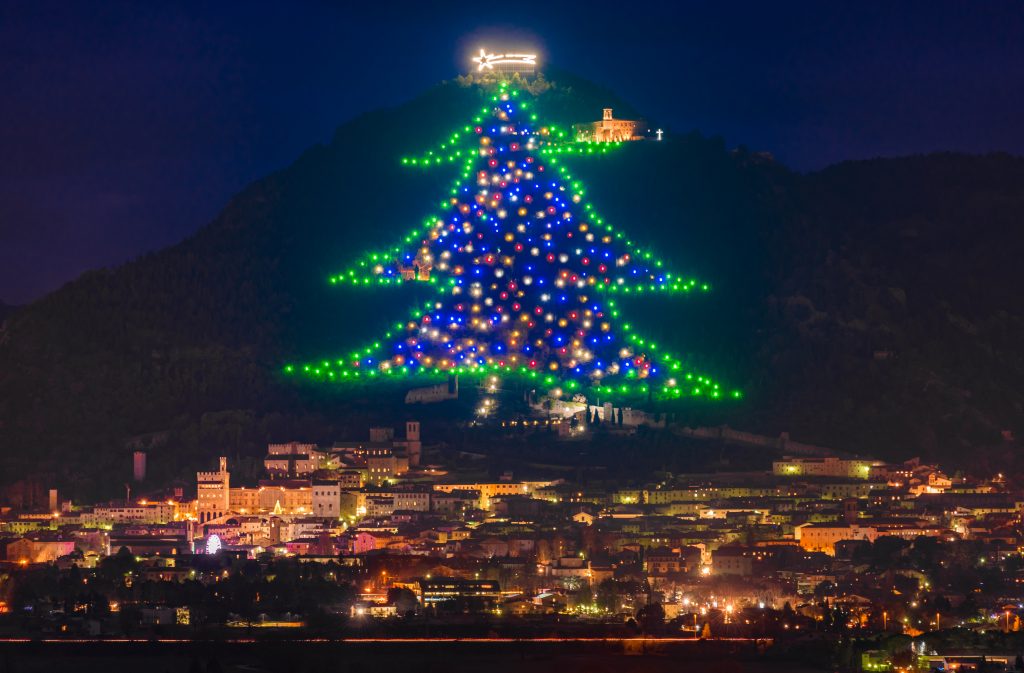
Un piatto semplice
Una dolce e antichissima tradizione che sopravvive nel più dolce dei rituali festivi, il Natale. I Maccheroni dolci sono un piatto semplice, particolare e quasi sconosciuto, nonostante sia delizioso, facile da preparare e sicuramente più salutare dei dolci che troviamo in questo periodo. Un dolce singolare, che troviamo nelle province etrusche italiane e in zone dell’Italia centrale che mai furono etrusche, ma romane, e perfino in Romania, nell’antica Dacia, colonia della Roma imperiale. Una testimonianza della mediazione romana tra i propri usi e quelli che assorbirono dagli Etruschi ed una prova comunque delle origini “anche dolci” della nostra pasta.

A proposito di origini, questo piatto si faceva anche a casa mia, lo preparava quella pioniera delle tradizioni di mia nonna, quindi non poteva esserci cornice migliore che “l’albero di Natale più grande del mondo” della mia Gubbio, una mastodontica realizzazione, 750 metri di altezza per una superficie di 130 mila metri quadri, composta da più di 700 luci che si estendono dalle mura medievali della città, fino alla cima del monte Ingino dove è situata la Basilica di S Ubaldo, patrono della città. Un albero da “Guinness world record” che nasce da due sentimenti: L’amicizia e la devozione per il patrono, valori che da sempre legano il genio artistico dei “Mastri eugubini” e che hanno generato in loro quella che, a partire dagli anni 70, era solo un idea, visionaria quanto folle, forse anche per questo appoggiata da tutta la comunità di Gubbio (città dei matti) che negli anni a seguire si è adoperata con un gruppo di volontari sempre più numeroso, per la realizzazione di questa difficile quanto meravigliosa opera, mettendo ognuno a disposizione i propri mezzi, esperienza e materiali.
Oltre 300 punti luminosi di colore verde per delinearne la sagoma; oltre 400 luci multicolore per il corpo centrale e alla sommità una stella cometa della superficie di circa mille metri quadri disegnata da oltre 250 punti luminosi; furono necessari circa 7.500 metri di cavi elettrici di vario tipo per realizzare i collegamenti e circa 1.300 ore di lavoro per l’installazione.
Fu così che il 7 dicembre del 1981 nacque “l’albero di natale più grande del mondo”, simbolo del natale e per come nasce, anche simbolo di unione, di volontà, di devozione, di amicizia. Sono i sentimenti più puri che generano le idee più originali, le realizzazioni più belle… e anche i piatti più buoni.
La ricetta dei maccheroni dolci
Ingredienti per la pasta:
- 300 gr di farina 00
- acqua calda q.b.
Ingredienti per il condimento:
- 100 gr miele
- 200 gr gherigli di noci
- pangrattato q.b.
Procedimento:
1. Impastare la farina con l’acqua calda fino ad ottenere un composto liscio ed omogeneo
2. Ripiegare il composto più volte su se stesso e formare un panetto
3. Avvolgere il panetto nella pellicola trasparente e lasciare riposare circa 30 minuti a temperatura ambiente
4. Trascorso in tempo necessario rimaneggiare il panetto, dividerlo in due o più parti e stenderli con un mattarello
5. Passare nel tirapasta fino ad ottenere una sfoglia sottile
6. Ripiegare ogni sfoglia formando un rotolino, appiattirlo delicatamente con le mani e con un coltello tagliare a fettine larghe circa un centimetro
7. Separare delicatamente le strisce ottenute prendendole dalle estremità e arrotolarle sul palmo della mano formando un nido.
8. Cuocere la pasta in acqua bollente
9. Togliere dal fuoco un pò al dente, scolare bene e impiattare
10. Sciogliere il miele in un tegamino
11. Tritare finemente i gherigli di noci mescolandoli con un pugno di pangrattato
12. Versare il miele caldo sulla pasta e aggiungere a mò di parmigiano il composto di noci e pangrattato
13. Servire “rigorosamente” freddi.
Note:
Nella mia versione rivisitata in chiave moderna ho aggiunto un pò di cacao nell’impasto ed ho decorato il piatto con dei fiocchi di oro 24k e delle foglie di frolla al cacao spolverate d’oro.
Maccheroni dolci (Sweet Macaroni)
A sweet and ancient tradition that survives in the sweetest of festive rituals: Christmas. Sweet Macaroni, is a simple, particular and almost unknown dish, despite being delicious, easy to prepare and certainly healthier than the desserts we find in this period. A particular dessert, which we find in the Italian Etruscan provinces and in areas of central Italy that were never Etruscan, but Roman, and even in Romania, in ancient Dacia, a colony of imperial Rome. A testimony of the Roman mediation between their own uses and those that they absorbed by the Etruscans and a proof of the equally “sweet” origins of our pasta.
Speaking of origins, this dish was also made in my family, prepared by my grandmother, a pioneer of traditions.
So there could be no better setting than “the largest Christmas tree in the world” in my Gubbio, a mammoth realization — 750 meters high spanning an area of 130 thousand square meters, composed of more than 700 lights that extend from the medieval walls of the city to the top of Mount Ingino where the Basilica of Saint Ubaldo, patron saint of the city, is located. A Guinness World Record tree that is born from two feelings: friendship and devotion to the patron. These values have always bound the artistic genius of the “Eugubini Masters” and have generated in them that which, starting from the 70’s, was just an idea, both visionary and insane.
Perhaps, also for this reason supported by the whole community of Gubbio (city of madmen) which in the following years worked with an increasingly numerous group of volunteers, to realize this difficult yet wonderful artwork. Everyone makes available their own means, experience and materials.
To put the Gubbio Christmas tree into perspective:
- Over 300 bright green spots outline the contours of the tree;
- Over 400 multicolored lights are used for the central body;
- At the top,sits a comet with a surface of about one thousand square meters drawn by over 250 luminous points;
- About 7,500 meters of electrical cables of various types were needed to make the connections; and
- About 1,300 hours of work for the installation.
And so on December the 7th 1981 “the largest Christmas tree in the world” was born. It’s a symbol of Christmas and also a of union, will, devotion, and friendship. It is the purest feelings that generate the most original ideas, the most beautiful creations … and also the best dishes.
Maccheroni dolci (Sweet Macaroni)
Ingredients for the dough:
- 300 grams of flour 00
- hot water as needed.
Ingredients for sauce:
- 100 gr honey
- 200 gr of walnut kernels
- breadcrumbs as needed.
Process:
1. Mix the flour with hot water until the mixture is smooth and homogeneous
2. Fold the mixture on itself several times and form a loaf
3. Wrap the dough in cling film and let it rest for about 30 minutes at room temperature
4. Rework the dough, divide it into two or more parts and roll them out with a rolling pin
5. Pass through the kneader to obtain a thin sheet
6. Fold each layer into a roll, flatten it gently with your hands and with a knife cut into slices about one centimeter wide
7. Gently separate the strips obtained by taking them from the ends and rolling them on the palm of the hand forming a nest.
8. Cook the dough in boiling water
9. Remove from the heat a little “al dente”, drain well and serve
10. Melt the honey in a saucepan
11. Finely chop the walnut kernels by mixing them with a handful of breadcrumbs
12. Pour the hot honey over the dough and add the mixture of walnuts and breadcrumbs as if it was Parmigiano.
13. Serve “strictly” cold.
Note:
In my version revisited in a modern way I added a little cocoa to the dough and I decorated the dish with 24k gold flakes and cocoa shortcrust pastry leaves dusted with gold.
Find More Live in Italy Magazine Recipes and Articles


